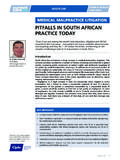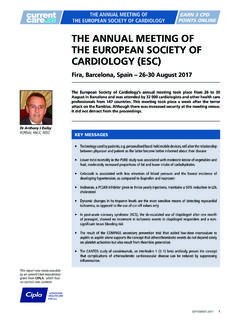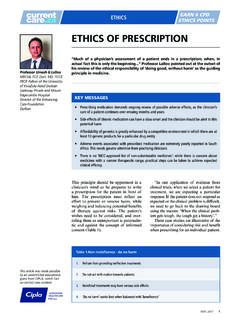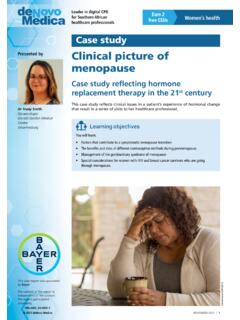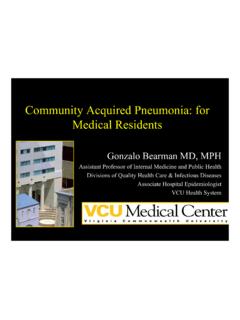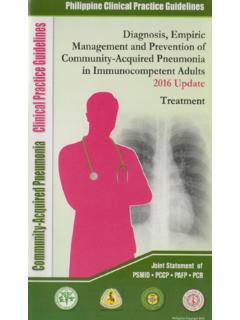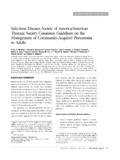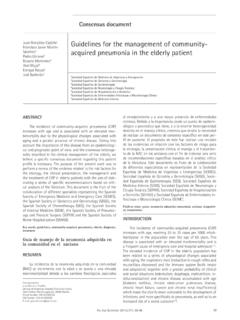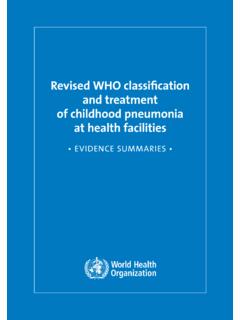Transcription of Community-aCquired pneumonia: evidenCe- based …
1 1earn 3 Cpd points onLineCommunity acquired PneumoniAmay 2017 Community-aCquired pneumonia : evidence - based management and antibiotiC stewardshipintroductionCommunity-acquire d pneumonia (Cap) is a common infectious disease with a high mortality rate. in south africa, pneumonia , influenza and tuberculosis are the leading causes of natural hospitalised patients with severe pneumonia are especially at risk of poor outcome. one-fifth of those admitted to the intensive care unit (iCu) and more than half of ventilated patients over the age of 65 with pneumonia will of CapIn data collected from adults with CAP who required hospitalisation in the USA, a causative pathogen was identified in only 38%, which in the majority of cases (23%) was a virus.
2 The most common viral pathogens were rhinovirus (9%) and influenza virus (6%). Bacterial causes were identified in 11% and mixed infec-tion with a bacterial pathogen and virus in 3%. The most common bacterial cause was Streptococcus pneumoniae (5%), whereas less common bacterial patho-gens included Mycoplasma pneumoniae, Staphylococcus aureus, Legionella pneu-mophila and In the ICU setting, Haemophilus influenzae is extremely the pneumococcal vaccine, which has in recent years been administered to both children and adults, may account for the decrease in incidence of infection with S pneumoniae.
3 The continued pre-dominance of infections caused by the influenza virus underscores the impor-tance of annual vaccinations against this pathogen, especially among vulnerable individuals, elderly. In HIV-positive patients, CAP becomes more common as the CD4 cell count falls. S pneumoniae and Mycobacterium tuberculosis are important pathogens. In general, the aetiology is similar to that in HIV-negative individuals, but H influ-enzae, S aureus, Gram-negative bacteria (GNB) and antibiotic-resistant bacteria are more common.
4 Opportunistic patho-gens may occur alone or in combination with conventional patients where CAP is suspected, there are no individual clinical findings or com-binations of findings that can confirm the diagnosis. However, the absence of abnormal vital signs or abnormalities on chest auscultation essentially rules out the diagnosis (Table 1).4 A chest X-ray is indicated in the presence of any of the signs listed in Table 1 or if a cough has been present for longer than three weeks.
5 Comorbidities and age may complicate a This module was sponsored by an unrestricted grant from CIPLA, which had no control over the Guy Richards Pulmonologist and Academic Head: Critical CareUniversity of the WitwatersrandDirector: Critical Care Charlotte Maxeke Johannesburg Academic HospitalJohannesburgDr Tom Boyles Consultant: Groote Schuur HospitalDivision of Infectious Diseases and HIV MedicineCape Townbased on presentations by table 1. Clinical features consistent with a diagnosis of Cap4 Fever 38oC Tachypnoea 24 breaths per minute Tachycardia 100 beats per minute evidence of consolidation on examination: crackles, bronchial breathing, fremitusCommunity acquired PneumoniA2may 2017earn 3 Cpd points on Accredited CPD modules.
6 Clinical diagnosis. Confusion may be the only symptom in elderly patients with that increase the likelihood of infection with antibiotic-resistant organisms are listed in Table 2 and clini-cal features suggestive of infection with methicillin-resistant S aureus (MRSA) are listed in Table 3. Examination of expectorated sputum has a low yield and is generally not useful, so it is usually only recommended for a subset of hospitalised patients before initiation of antibiotic therapy (Table 4).
7 5 Nevertheless, care must be taken when interpreting cul-ture results, so as not to confuse colonising bacteria with causative proteinIn conjunction with clinical examination, raised C-reactive protein (CRP) may be useful to support the diagnosis of CAP (cut-off value 33mg/l). Raised CRP val-ues are especially high in patients with pneumonias caused by S pneumoniae or L pneumophila and CRP is higher in more severe In patients with severe CAP, serial CRP measurement during the first week of treatment may be useful to monitor recovery.
8 Decline in CRP <60% in three days or <90% in seven days indi-cates that empirical antibiotic treatment is inappropriate or that complications have CRP testing in the community settingThe majority of antibiotic use occurs in the community (80%), with prescribing for respiratory tract infections (RTIs) account-ing for a considerable proportion of this. Most community RTIs are viral infections and self-limiting, so antibiotics are unnec-essary. This is especially true of upper RTIs, including sore throat, otitis media and sinusitis, which are relatively simple to diagnose clinically and are usually self-limiting.
9 However, it is estimated that 80% of patients with acute RTIs receive an anti-biotic, 60% of which are the case of lower RTIs, acute bron-chitis is invariably viral and antibiotics are of no value. In contrast, an antibiotic may be necessary in acute bacterial exacerba-tions of chronic bronchitis (AECB) and is always indicated for CAP. An accurate diagnosis is therefore essential. 9 In the primary care setting, in the case of diagnostic uncertainty, point-of-care tests (POCTs) for CRP may be helpful in table 3.
10 Clinical features suggesting infection with mrsa6 Cavitary infiltrate or necrosis Rapidly increasing pleural effusion Gross haemoptysis (not just blood streaked) Concurrent influenza Neutropenia Erythematous rash Skin pustules Young, previously healthy patient Severe pneumonia during summer monthstable 2. Factors associated with higher likelihood of infection with antibiotic-resistant bacteria5 Age > 65 years Alcoholism Immune suppression (including corticosteroids and HIV infection) Bronchiectasis/severe COPD with previous administration of multiple antibiotics Exposure to children in day care Antibiotics in the last three months, especially fluoroquinolones and macrolidestable 4.
